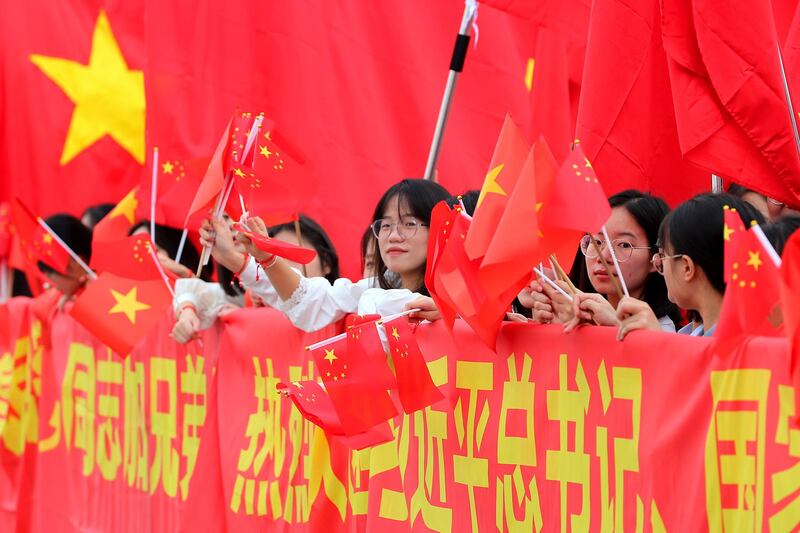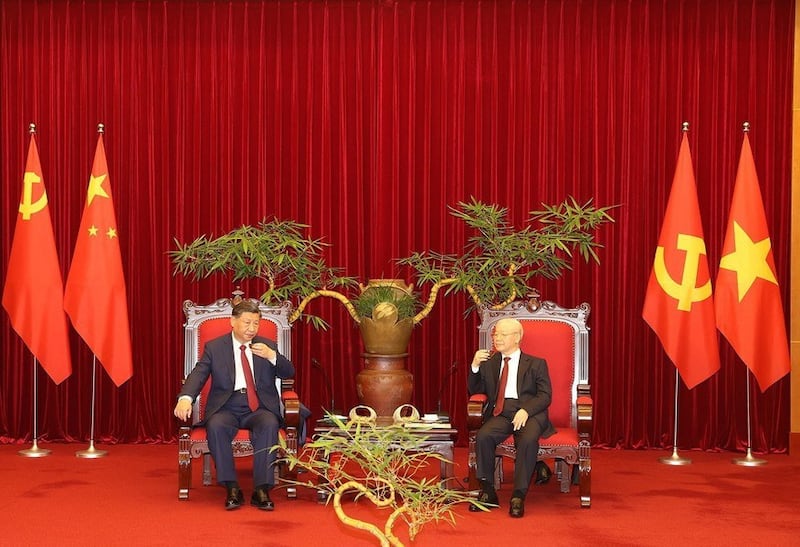Vietnam has become the latest country in Southeast Asia to have agreed to the China-led “Community with a Shared Future,” Beijing’s vision for a new global order.
The agreement was announced at a meeting on Tuesday in Hanoi between Chinese leader Xi Jinping, who is in Vietnam on a two-day state visit, and Nguyen Phu Trong, the general secretary of the ruling Communist Party of Vietnam (CPV).
"Vietnam considers developing the relationship with China its top priority and a strategic choice," Trong was quoted by the CPV's mouthpiece Nhan Dan as saying.
“Vietnam and China are neighbors sharing strong political and ideological ties, making Xi’s call for a China-Vietnam ‘Community with a Shared Future’ strategically important,” said Huynh Tam Sang, a lecturer at Vietnam National University.
“This occurs at the same time when Vietnam’s relations with South Korea, the United States and Japan have been elevated to the ‘comprehensive strategic partnership’ level, which is on par with China’s,” Sang told Radio Free Asia.
“Beijing has likely attempted to boost ties with Hanoi to keep Vietnam within its reach,” the Vietnamese lecturer noted.
State media in both China and Vietnam have been highlighting the two countries’ closeness and similarities in their political systems.
"China and Vietnam are connected by mountains and rivers. We enjoy cultural proximity, cherish the same ideals, and have a shared future ahead of us," wrote Xi in a signed article ahead of his trip, the third to the neighboring country since he became general secretary of the Communist Party of China.
Alternative global order
The concept of a ‘Community with a Shared Future’ was originally coined as a ‘Community of Common Destiny’.
“The term had been floating around since the early 2000s, but Xi Jinping formally made it part of the PRC’s foreign policy and put it into its constitution in 2017,” said Ian Chong, a political scientist from the National University of Singapore, referring to China by its official name the People’s Republic of China.
Beijing released the full text of China's proposals and actions for 'A Global Community of Shared Future' in September.
“This is China's proposed framework for international relations in the Xi Jinping era,” said Nguyen Khac Giang, a visiting fellow at the think tank ISEAS–Yusof Ishak Institute in Singapore. “This concept is often perceived as China's endeavor to reshape, or even create an alternative, global order.”
“As a nation that has significantly benefited from deep integration into the existing global order, Vietnam until now has been resisting China’s pressure to join this initiative,” he said, adding “The Vietnamese populace, bearing a long and complex history with China, appears disinterested in the concept.”

Communist Vietnam and China are traditional allies but the relationship between them has been far from smooth-sailing. Hanoi and Beijing had a brief war in 1979 and bloody skirmishes took place on their common border during the 1980s.
The two countries have also been confronting each other over their territorial claims in the South China Sea.
However, since the normalization of bilateral ties in 1991, China has become Vietnam’s top trade partner with the most economic influence over the smaller neighbor.
Chong from the National University of Singapore said that in his opinion, China “is trying to reach out at the moment, given trouble at home and more vigorous competition from the U.S. and its allies.”
“So while it may not transform into anything concrete, not joining [the ‘Community with a Shared Future’] could seem like a direct rebuff of Xi,” Chong told RFA. “That may be something Vietnam and other regional states would like to avoid.”
On the other hand, joining can help Hanoi “signal goodwill and look for possible areas of economic exchange,” he said.
During Xi’s visit, the two sides signed 36 agreements of bilateral cooperation in multiple fields, according to state media.
“Building a community with a shared future for mankind should start from Asia,” Xi wrote in his recently signed article.
“The wording in Xi’s article serves as a reminder that the future of Asian countries, like China and Vietnam, should be run solely by Asians,” said Huynh Tam Sang from Vietnam National University.
“Yet, China – as perceived by Xi and his comrades – is the driving force for the future of Vietnam and other Asian countries.”
‘Bamboo diplomacy’
Before Vietnam, seven other Southeast Asian nations – Laos, Cambodia, Myanmar, Thailand, Brunei, Malaysia, and Indonesia – have already agreed to join the China-led community.
However, the commitment is higher in Cambodia and Laos, but lower in Thailand, Brunei, Indonesia, Malaysia, and Vietnam, according to Alexander Vuving, a professor at the Daniel K. Inouye Asia-Pacific Center for Security Studies in Hawaii.
"Singapore and the Philippines are unlikely to take China's side anytime soon," wrote Vuving onX, formerly known as Twitter.
“With 8 out of 10 members being within China's ‘Community with a Shared Future’, ASEAN is shrinking deeper into irrelevance, as demonstrated in the ongoing South China Sea conflict, he added.
In Vietnam’s case, Hanoi insisted that the text include additional words “in accordance with the U.N. Charter and international law, based on the principles of mutual respect, equal cooperation for mutual benefits, mutual respect of independence, sovereignty, and territorial integrity, and perseverance in solving disputes through peaceful measures.”
This year marks the 15th anniversary of the comprehensive strategic partnership between the two countries.
“Vietnam understands that despite unresolved disputes in the South China Sea it needs to maintain cooperative relations with China, for both security and economic reasons,” said Zhang Baohui, a professor at Lingnan University in Hong Kong.
Zhang said that supporting China’s “Community with a Shared Future,” at the same time maintaining cooperative relations with the U.S. and Japan, represents Hanoi’s “benign signaling” to Beijing.
Visits by world leaders to Hanoi, in his opinion, show “Hanoi’s sophisticated diplomacy with the great powers.”

Vietnam’s policy makers have been promoting the concept of “bamboo diplomacy,” symbolized by the ability of the bamboo tree to bend with the wind but never break.
During a one-to-one tea session with Xi in Trong’s office, an intricate decoration with two bamboo branches spiraling out of a common vase is seen in the background.
The two leaders sipped cups of Vietnamese green tea.
“The Vietnamese leadership decided to build a shared future with China most probably out of geopolitical concerns,” said Truong Nhan Tuan, a France-based Vietnamese political commentator.
“But Hanoi should always bear in mind Beijing’s ambitions,” warned Tuan, adding “and the United States should also be concerned about Vietnam getting closer to China.”
Edited by Taejun Kang and Mike Firn.
